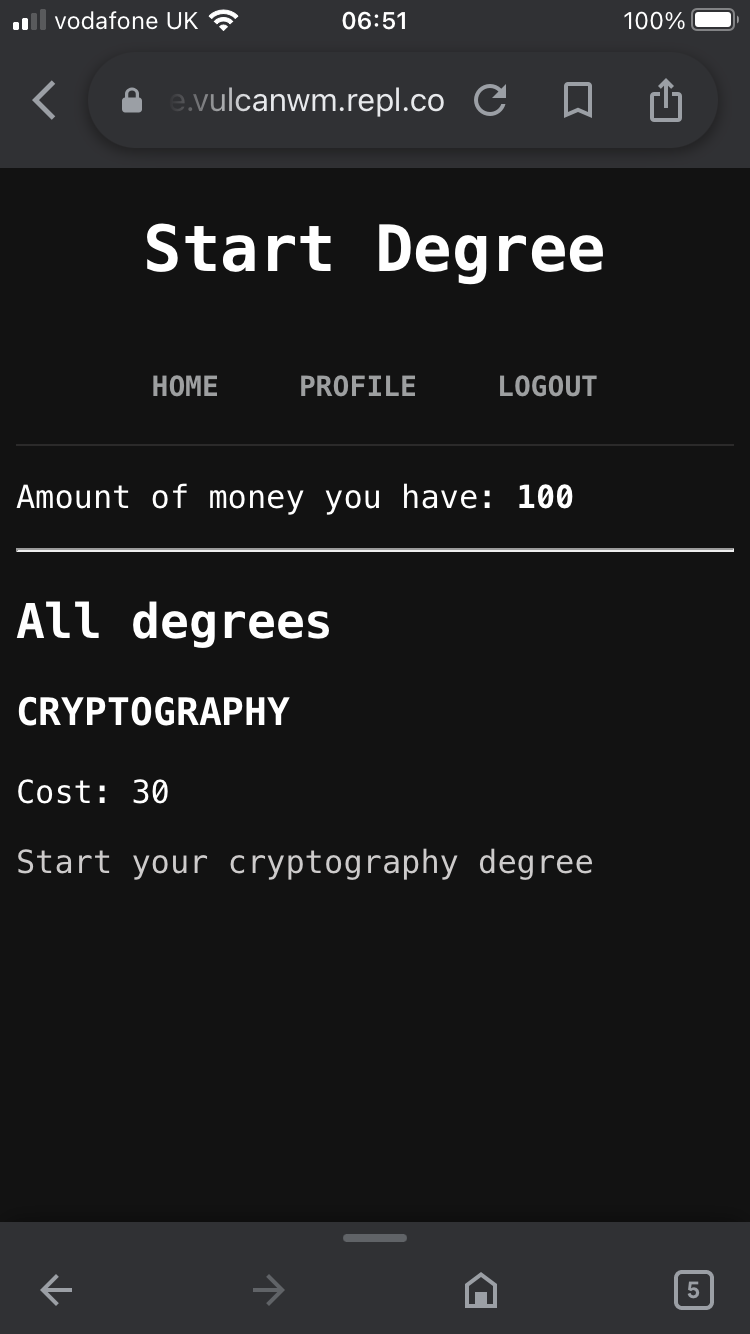
Medea
Posted on April 4, 2022
So yesterday, I worked on starting a degree.
This is how I did it:
First I perfectioned the adddegree function, by adding this code to functions.py:
def getpreparingdegreesnames(username):
myquery = { "Username": username }
mydoc = degreescol.find(myquery)
jobs = []
for x in mydoc:
jobs.append(x)
preparing = []
for x in jobs:
if x['Status'] != True:
preparing.append(x['Type'])
return preparing
def getfinisheddegreesnames(username):
myquery = { "Username": username }
mydoc = degreescol.find(myquery)
jobs = []
for x in mydoc:
jobs.append(x)
preparing = []
for x in jobs:
if x['Status'] == True:
preparing.append(x['Type'])
return preparing
Then, in the adddegree function, I added the code below, before the degree document is added to the collection code:
if jobname in getpreparingdegreesnames(username):
return "You are already preparing for this degree!"
if jobname in getfinisheddegreesnames(username):
return "You have already obtained this degree!"
Now, if you try to start a degree which you have starting preparing for, or have already obtained it, you can't start preparing for it again.
Next, I created an HTML page for starting the degree, called startdegree.html in the templates folder, and added the following code to it:
<!DOCTYPE html>
<html lang="en-GB">
<head>
<meta charset="utf-8">
<meta name="viewport" content="width=device-width">
<title>Myfe - Start Degree</title>
<link href="/style.css" rel="stylesheet" type="text/css" />
<script src="/script.js"></script>
</head>
<body>
<div class="header">
<h1>Start Degree</h1>
</div>
<div class="navbar">
<script>
navbaredit(['home', 'profile', 'logout'])
</script>
</div>
<div class="content">
{% if error != False and error != None and error != "" %}
<p>{{error}}</p>
{% endif %}
<p>Amount of money you have: <strong>{{user['Money']}}</strong></p>
<hr>
<h2>All degrees</h2>
{% for degree in degrees %}
<h3>{{degree|upper}}</h3>
<p>Cost: {{degreescosts[degree]}}</p>
<a href="/startdegree/{{degree}}">Start your {{degree}} degree</a>
{% endfor %}
</div>
</body>
</html>
Then, I added the code below to app.py to render the startdegree.html file and make the adddegree function work for users:
from lists import degrees, degreescosts
from functions import adddegree
@app.route("/startdegree")
def startdegree():
if getcookie('User') == False:
return redirect("/")
else:
return render_template("startdegree.html", degrees=degrees, degreescosts=degreescosts, user=getuser(getcookie("User")))
@app.route("/startdegree/<degree>")
def startdegreefunc(degree):
if getcookie("User") == False:
return redirect("/")
func = adddegree(getcookie("User"), degree)
if func == True:
return render_template("startdegree.html", degrees=degrees, degreescosts=degreescosts, user=getuser(getcookie("User")), error=f"You have started preparing for your {degree} degree!")
else:
return render_template("startdegree.html", degrees=degrees, degreescosts=degreescosts, user=getuser(getcookie("User")), error=func)
So now the page on the startdegree route looks like this:
Then I decided to create an email for Myfe:
themyfe@gmail.com
And for promoting the game to a wider audience I created a Twitter Account for Myfe:
https://mobile.twitter.com/@themyfe
So next I’ll be working on starting to achieve your cryptography degree.
Thanks for reading!

Posted on April 4, 2022
Join Our Newsletter. No Spam, Only the good stuff.
Sign up to receive the latest update from our blog.
